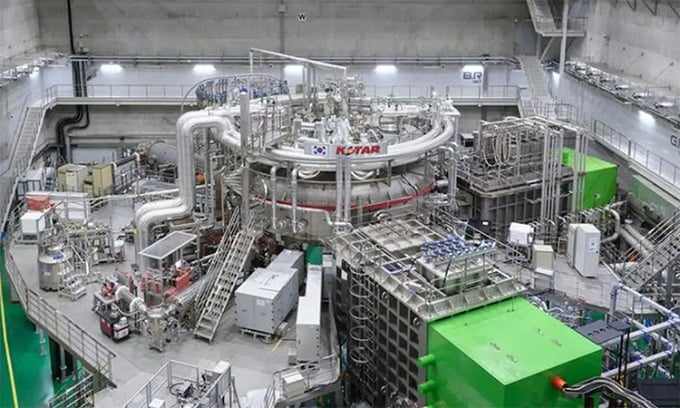South Korea Using a new tungsten diverter, the KSTAR fusion reactor successfully maintained a temperature of 100 million degrees Celsius for 48 seconds.

South Korea's KSTAR fusion reactor. Photo: KFE
The Korea Advanced Research Superconducting Tokamak (KSTAR) fusion reactor of the Korea Institute of Fusion Energy (KFE) reached a temperature of 100 million degrees Celsius for the first time. This achievement took place during the testing period from December 2023 to February 2024, marking a new record for the KSTAR project.
KSTAR successfully maintained a temperature of 100 million degrees Celsius for 48 seconds. Meanwhile, the temperature of the Sun's core is 15 million degrees Celsius. In addition, the reactor also maintained the high limit mode (H mode) for more than 100 seconds. H mode is an advanced operating mode in magnetically confined fusion with a stable plasma state.
Fusion reactions mimic the process that produces light and heat from stars. The process involves merging hydrogen and other light elements to release enormous amounts of energy. Experts hope to use fusion reactors to generate an unlimited source of carbon-free electricity.
According to the National Council for Science and Technology (NST), it is crucial to create a technology that can maintain high temperatures and high-density plasmas for the most efficient fusion reactions over long periods of time. The secret behind these great achievements, according to NST, is the tungsten diverter. This is a key component at the bottom of the vacuum tank in the magnetic fusion device, playing a key role in pushing waste gases and impurities out of the reactor while still withstanding the large surface heat load.
The KSTAR team switched to using tungsten instead of carbon in the divertor. Tungsten has the highest melting point of any metal. KSTAR's success in maintaining H mode for longer periods of time is also largely due to this upgrade. "Compared to previous carbon divertors, the new tungsten divertor only experiences a 25% increase in surface temperature under the same thermal load. This is a significant benefit for long-pulse high-thermal power operations," NST explained.
The success of the tungsten divertor could provide valuable data for the International Thermonuclear Experimental Reactor (ITER) project. ITER is a $21.5 billion international fusion megaproject being developed in France with the participation of dozens of countries, including South Korea, China, the United States, EU countries and Russia. ITER is expected to achieve its first plasma state in 2025 and begin operations in 2035. Tungsten will be used in the reactor’s divertor.
Thu Thao (According to Interesting Engineering )
Source link




































































































Comment (0)